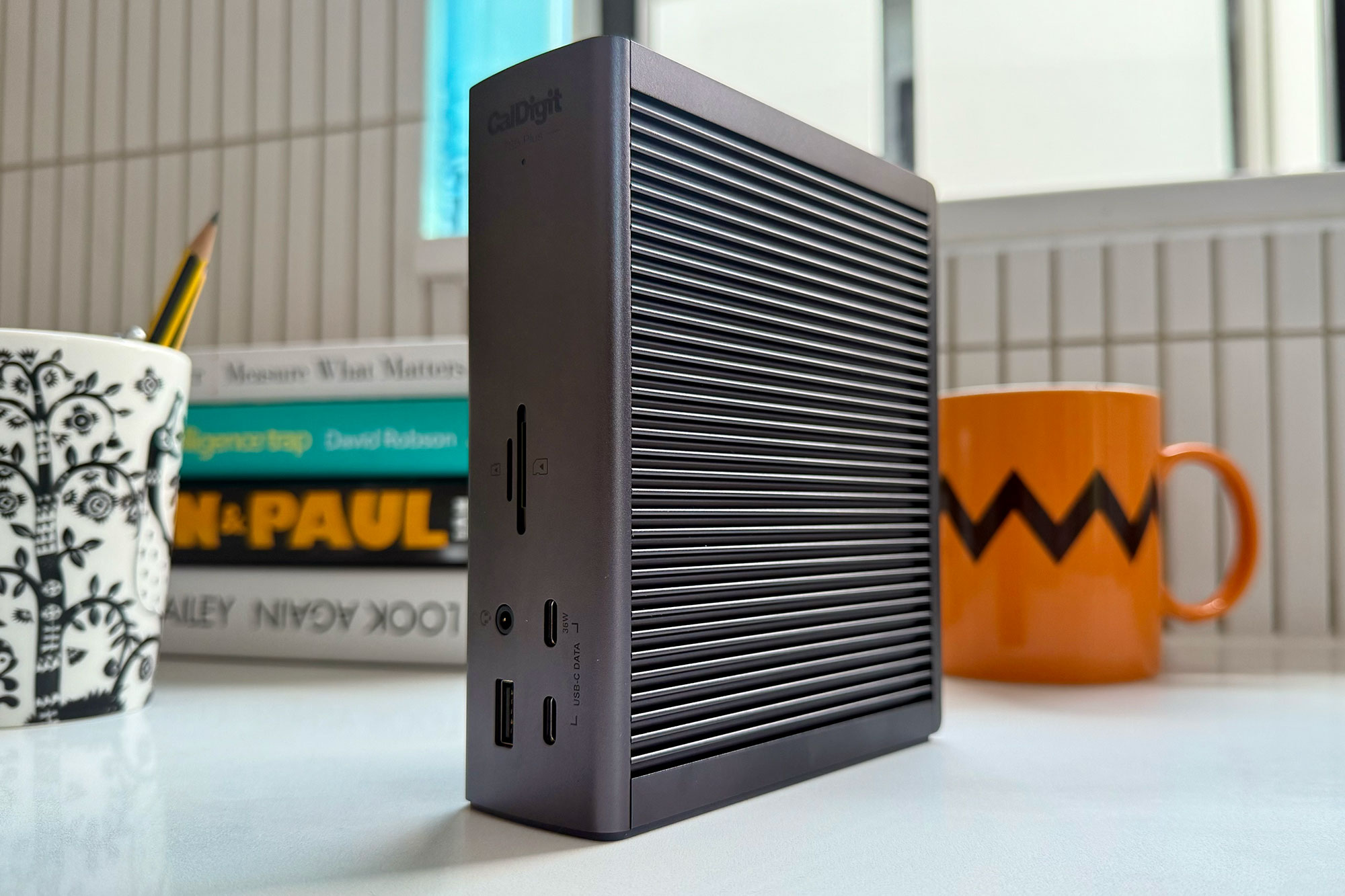Best Thunderbolt and USB-C docking stations for your MacBook
Description
Plug your MacBook in and out of a multi-port laptop docking station to swiftly add multiple devices and external displays with just one cable connection to your laptop. We tested the top contenders to find the best Thunderbolt and USB-C docks available to owners of the MacBook Air and MacBook Pro.
Thunderbolt, USB4 or USB-C
The connectors all look the same (technically known as a “Type-C connector”), but there are significant differences, particularly on speed that will determine both data-transfer rate and higher external display refresh rates.
- USB-C: 5Gbps or 10Gbps
- USB4: 20Gbps or 40Gbps
- Thunderbolt 3 and 4: 40Gbps
- Thunderbolt 5: 80Gbps / 120Gbps
Our list Which ports does my MacBook have will show you how many USB-C or more likely one of Thunderbolt 3, 4 or 5 that you have.
While an older Thunderbolt 3 (TB3) dock will be enough for most casual users, if you can stretch the budget go for a TB4 or TB5 dock as they will remain current for years, saving you money in the long term. High-end professionals should aim for Thunderbolt 5.
The dock needs one (“upstream“) Thunderbolt or USB-C port for connecting to and charging your laptop (although all recent MacBooks can also power via the MagSafe 3 port), and at least another (“downstream“) to attach further devices (hard drives, external display, and others).
For more detail, read our Thunderbolt 5 vs Thunderbolt 4 vs Thunderbolt 3 vs USB4 explainer.
Add external displays to your MacBook
If you use your laptop as your principal computer, attaching at least one larger display to create a hybrid desktop/laptop setup, with a keyboard and mouse, will boost your productivity. You can turn that 13in MacBook’s cramped screen real-estate into an iconic iMac-sized 27in or even larger screen by adding an extra display—or connect two or even four large monitors to extend your screen across your whole desk. Take a look at our recommended best monitors and displays for Mac and also the best portable monitors for Mac.
You’ll get two or more Extended mode screens (where the screen extends beyond what you can see on the laptop screen) using a Thunderbolt connection (or DisplayPort/HDMI). Natively over mere USB-C, Macs can connect to only one external display in Extended mode, as opposed to Mirrored mode (which replicates exactly what you get on the laptop screen) but DisplayLink is third-party software that allows some docks to extend to up to four screens on even the most basic Mac. DisplayLink-supporting docks are also the only way that non-Pro/Max M1 and M2 MacBooks can connect more than one external display.
More explained: we cover more on Mac docking stations and external displays at the end of this feature below our recommendations.
Do I need a docking station?
With three TB4 or TB5 and an HDMI port, a MacBook with a Max chip could connect to up to four external displays without the need for a dock, although such a power user would likely require extra Thunderbolt and other ports for more devices to make up for using all the laptop ports for multiple monitors. See below our list of recommended docking stations for more detail on the external display options with each recent MacBook.
All docks come with a bunch of USB ports: some old-school USB-A and newer, more capable USB-C. MacBook Pros also have an SD card reader. Although this card reader is rated as UHS-II (312MBps), Apple has pegged it back at 250MBps, so for the fastest speeds (and a microSD slot if you need one), a dock will likely be a better choice for memory-card use if it is rated at UHS-II rather than UHS-I (104MBps).
MacBooks also lack wired Internet access via an Ethernet port, so if you want to escape flaky Wi-Fi, buy a dock with at least Gigabit Ethernet, although you could add a Thunderbolt-to-Ethernet adapter instead if you have a spare TB port. Some later docks include faster 2.5Gb, 5Gb or even 10Gb Ethernet but you’ll need a supporting router or other device to get the benefits, although these faster Ethernet ports are backwards compatible with Gigabit so will future-proof your purchase.
Dock or hub?
If you need just a few extra ports, a USB-C hub or Thunderbolt hub might be your best choice—see our roundup of the best USB-C and Thunderbolt hubs for Mac. However, if you require a bunch of fast ports including Gigabit (or faster) Ethernet and multiple video ports plus more powerful charging capability, then look for a full dock that fulfils your needs. We’ve reviewed the best below alongside the docks.
USB-C and Thunderbolt speeds
 <button class="lightbox-trigger" type="button">
<button class="lightbox-trigger" type="button"><svg fill="none" height="12" viewBox="0 0 12 12" width="12" xmlns="http://www.w3.org/2000/svg">
<path d="M2 0a2 2 0 0 0-2 2v2h1.5V2a.5.5 0 0 1 .5-.5h2V0H2Zm2 10.5H2a.5.5 0 0 1-.5-.5V8H0v2a2 2 0 0 0 2 2h2v-1.5ZM8 12v-1.5h2a.5.5 0 0 0 .5-.5V8H12v2a2 2 0 0 1-2 2H8Zm2-12a2 2 0 0 1 2 2v2h-1.5V2a.5.5 0 0 0-.5-.5H8V0h2Z" fill="#fff"></path>
</svg>
</button></figure>
Simon Jary / Foundry
• USB and Thunderbolt speeds explained
USB PD: Power Delivery for your laptop
Most docks can charge the connected MacBook, so look for the right Power Delivery (PD) rating that suits your laptop. You can’t over-power a MacBook so the simplest advice is to aim as high as you can. 70W will be more than enough to fast-charge a MacBook Air but go for 85W or more for a MacBook Pro, and 140W for the top-end 16-inch Pro.
We’ve got more detailed advice on recommended MacBook charging speeds below our list of docks.
Best docks for Mac 2025
Here we list the Thunderbolt and USB-C docks that we have reviewed and tested. Read the descriptions for details on all the features and functions offered by each docking station.
We start with the latest Thunderbolt 5 docks as they offer the most but docks with TB4 and even TB3 might be all you need and often (not always) come in cheaper. The benefit of buying a Thunderbolt 5 dock now—even if your Mac doesn’t have it—is that it’s backwards compatible and future proofs you for your next Mac purchase.
CalDigit TS5 Plus – Ultimate Thunderbolt 5 dock for Macs
<figure class="wp-lightbox-container">
 <button class="lightbox-trigger" type="button">
<button class="lightbox-trigger" type="button"><svg fill="none" height="12" viewBox="0 0 12 12" width="12" xmln





